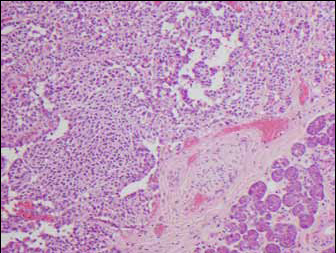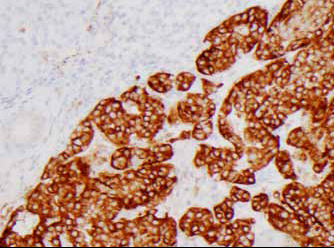Abstract
Carcinoid tumours are slow growing tumours of neuroendocrine origin that primarily affect the gastrointestinal tract and pulmonary system. They can behave aggressively, with regional and distant metastases, although metastases to the head and neck region are uncommon. We present a rare case of carcinoid metastasis to the submandibular gland, which to the best of our knowledge has not been previously reported in the literature.
Keywords: Carcinoid, Submandibular gland, Metastasis
Carcinoid tumours are slow-growing malignancies of neuroendocrine origin. They primarily present in the gastrointestinal tract (approximately 67% of the time) and also the bronchopulmonary system (approximately 25% of the time). Within the gastrointestinal tract, the small and large intestines and appendix are common sites for such tumours. They are relatively rare, forming less than 0.5% of overall malignancies. The Caucasian population does have a predilection and the sex distribution varies depending on the site of presentation. Although they are reported to be benign, their clinical behaviour can be rather aggressive with a tendency for regional and distant metastasis and overall survival rates reported at 67%.1
Metastases to parotid glands have been reported in rare instances2–4 and there is a single case report on the occurrence of a carcinoid in the parotid as a primary lesion.5 Although metastasis of an atypical carcinoid to cervical lymph nodes has been reported in the past,6 there is no reported case of carcinoid metastasis to the submandibular gland itself.
We present a case of metastasis of a bronchopulmonary carcinoid to the submandibular gland, which we believe is the only such case reported in the literature.
Case history
A 56-year-old male presented with a 3-month history of a mass in the right submandibular region that was slowly increasing in size but otherwise largely asymptomatic. His past medical history included acoustic neuroma and a bronchopulmonary carcinoid tumour for which he underwent a pneumonectomy nine years earlier. Although margins were clear at the time, he was diagnosed with mediastinal recurrence four years following surgery. This was treated by chemotherapy with six cycles of carboplatin and etoposide. Unfortunately, a year later there was further evidence of progressive disease in the mediastinum and radical radiotherapy (60Gy/30 fractions) was administered. On this occasion good response was shown and control over the disease was thought to have been achieved, which was approximately 18 months prior to his presentation to our team.
Clinically, the mass appeared to be an enlarged unilateral submandibular gland with no associated cervical lymphadenopathy. Fine needle aspiration suggested the possibility of a lymphoma or even a metastatic carcinoid. A core biopsy was performed subsequently, which was unfortunately inconclusive. The multidisciplinary team’s consensus was to perform an excision of the submandibular gland to obtain a histological diagnosis. The definitive histopathology report of the submandibular gland confirmed the presence of a moderately differentiated neuroendocrine carcinoma that represented metastatic disease from the previous carcinoid lung tumour. Immunohistochemistry was positive for neuroendocrine markers: chromogranin, synaptophysin, S100, CD56 and neuron-specific enolase.
Following confirmation of the presence of a metastatic carcinoid in the submandibular gland, the patient was referred back to the oncologists for further management. Octreotide and further computed tomography indicated metastases in the left adrenal gland and mediastinum and the patient’s further management is currently being formulated by the multidisciplinary team.
Figure 1.

Histopathology slide (hematoxylin and eosin stain)
Figure 2.

Chromogranin marker
Discussion
Although carcinoid tumours can present in extra gastrointestinal sites, their presentation (both primary and metastatic) in the head and neck region remains extremely rare. Carcinoid metastases to the parotid gland has been reported; there are no reports of carcinoid metastases to the submandibular gland.2–6 The case also highlights the aggressive nature of carcinoid tumours where multiple recurrences are reported up to nine years following the initial diagnosis and treatment.
It is therefore important to consider a carcinoid in the differential diagnosis of salivary gland masses where patients may have been previously diagnosed or treated for carcinoid tumours elsewhere in the body.
Acknowledgement
The authors would like to thank Dr Shireen Haider, Consultant Pathologist, for her help in preparing and obtaining the histopathology slides.
References
- 1.Modlin IM, Lye KD, Kidd M. A 5-decade analysis of 13,715 carcinoid tumors. Cancer 2003; 97: 934–959. [DOI] [PubMed] [Google Scholar]
- 2.Chan SW, Sizeland AM. Carcinoid tumour of the parotid gland. Med J Aust 2000; 173: 276–277. [DOI] [PubMed] [Google Scholar]
- 3.Dilkes MG, Birchall MA. Bilateral parotid secondaries from primary bronchial carcinoid tumour. J Laryngol Otol 1991; 105: 489–490. [DOI] [PubMed] [Google Scholar]
- 4.Eusebi V, Pileri S, Usellini L et al. . Primary endocrine carcinoma of the parotid salivary gland associated with a lung carcinoid: a possible new association. J Clin Pathol 1982: 35: 611–616. [DOI] [PMC free article] [PubMed] [Google Scholar]
- 5.Modlin IM, Shapiro MD, Kidd M. Primary carcinoid tumor of the parotid gland: a case report and review of the literature. Ear Nose Throat J 2006; 85: 533–539. [PubMed] [Google Scholar]
- 6.Fortson JK. Atypical carcinoid of the lung with cervical and submandibular lymphadenopathy: a case report. J Natl Med Assoc 1993; 85: 65–69. [PMC free article] [PubMed] [Google Scholar]


